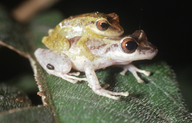|
Description
Males 19-21 mm, females 22-26 mm. The dorsum is greenish to yellowish with dark brown markings. There is a distinct yellow or brown line between the eyes, and a dark triangular mark on the back of the head. The ventral surface is whitish to yellowish with tiny golden dots. The throat region is yellowish. The iris is reddish to golden. Distribution and Habitat
Country distribution from AmphibiaWeb's database: Bolivia, Brazil, Colombia, Peru
Encountered frequently throughout the Reserva Florestal Adolpho Ducke in Brazil.Life History, Abundance, Activity, and Special Behaviors
The species is arboreal and nocturnal. Reproduction occurs in the rainy season (November to May). Males start calling at dusk, from leaves of shrubs or palms about 2 m above the ground; generally in groups of 2-5. Clutches are probably small, with large eggs deposited on the ground, and development to metamorphosis takes place within the egg, as occurs in other members of the genus. Comments
Similar species: Pristimantis fenestratus has a cream ventral surface, and a gray throat region with dark markings. Pristimantis ockendeni has transverse bars on the hind limbs, a brown dorsum, a throat region with diffuse dark markings, and a ventral surface without tiny golden dots.
Originally submitted by: Albertina P. Lima, William E. Magnusson, Marcelo Menin, Luciana K. Erdtmann, Domingos J. Rodrigues, Claudia Keller, Walter Hödl (first posted 2007-12-05)
Edited by: Kellie Whittaker (2007-12-12)Species Account Citation: AmphibiaWeb 2007 Pristimantis zimmermanae <https://amphibiaweb.org/species/3294> University of California, Berkeley, CA, USA. Accessed Jan 1, 2025.
Feedback or comments about this page.
Citation: AmphibiaWeb. 2025. <https://amphibiaweb.org> University of California, Berkeley, CA, USA. Accessed 1 Jan 2025.
AmphibiaWeb's policy on data use.
|
